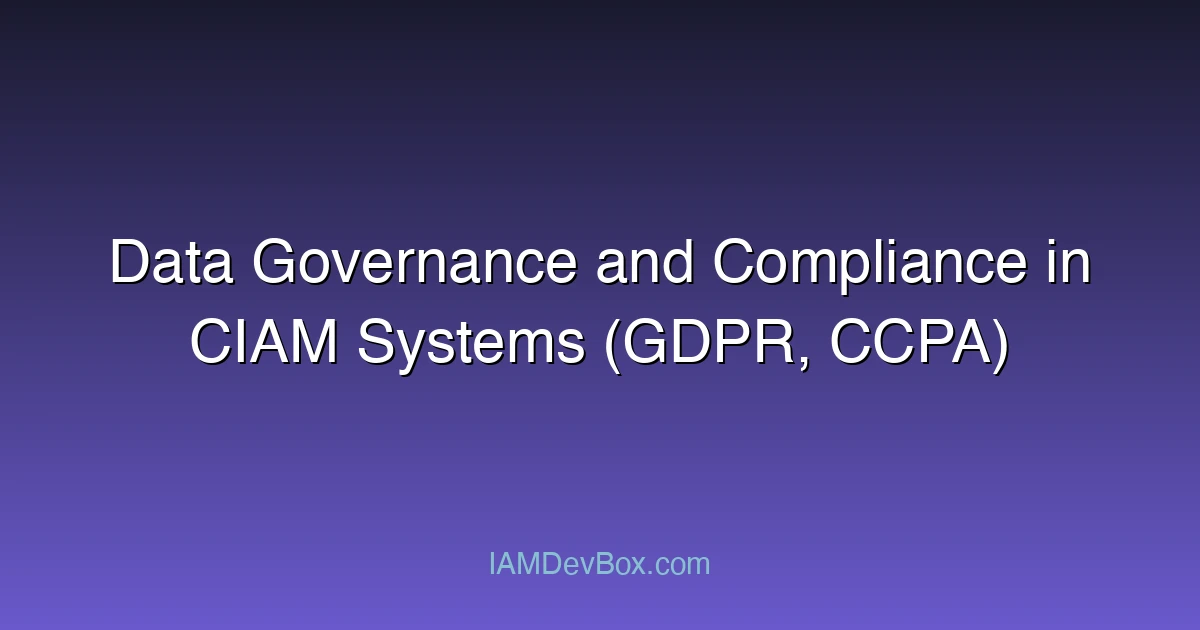In today’s digital landscape, customer identity and access management (CIAM) systems play a critical role in protecting user data and ensuring compliance with regulations. The General Data Protection Regulation (GDPR) and the California Consumer Privacy Act (CCPA) are two significant regulations that require organizations to implement robust data governance and compliance measures. In this blog post, we will explore the importance of data governance and compliance in CIAM systems and provide guidance on how to achieve compliance with GDPR and CCPA.
The Importance of Data Governance
Data governance is the process of managing an organization’s data assets to ensure they are accurate, complete, and secure. In the context of CIAM systems, data governance is essential for protecting customer data and ensuring compliance with regulations. Effective data governance involves several key components, including:
- Data quality: Ensuring that customer data is accurate, complete, and up-to-date.
- Data security: Protecting customer data from unauthorized access, use, or disclosure.
- Data access: Controlling who has access to customer data and ensuring that access is granted based on need-to-know principles.
- Data retention: Ensuring that customer data is retained for only as long as necessary and that it is deleted or anonymized when no longer needed.
Compliance with GDPR and CCPA
The GDPR and CCPA are two significant regulations that require organizations to implement robust data governance and compliance measures. The GDPR is a European Union regulation that requires organizations to protect the personal data of EU citizens, while the CCPA is a California regulation that requires organizations to protect the personal data of California residents.
Both regulations require organizations to implement robust data governance measures, including:
-
Data mapping: Identifying and mapping all customer data assets.
-
Data breach notification: Notifying customers in the event of a data breach.
-
Data subject rights: Providing customers with the right to access, correct, or delete their personal data.
-
Data protection impact assessments: Conducting assessments to identify and mitigate data protection risks.
Implementing Data Governance and Compliance in CIAM Systems
Implementing data governance and compliance in CIAM systems requires a multifaceted approach that involves several key components, including:
- Data governance policies: Establishing policies and procedures for managing customer data.
- Data governance tools: Utilizing tools and technologies to support data governance, such as data catalogs, data quality tools, and access controls.
- Data governance training: Providing training and awareness programs for employees to ensure they understand the importance of data governance and compliance.
- Continuous monitoring: Continuously monitoring and assessing the effectiveness of data governance and compliance measures.
Real-World Examples of Data Governance and Compliance in CIAM Systems
Several real-world examples illustrate the importance of data governance and compliance in CIAM systems. For example:
- In 2018, Facebook faced a major data breach that exposed the personal d
ata of millions of users. The breach highlighted the importance of implementing robust data governance and compliance measures to protect customer data. 2. In 2020, Google faced a CCPA compliance notice from the California Attorney General’s office, which alleged that Google had failed to provide adequate notice to California residents about its data collection practices.
Conclusion
Data governance and compliance are critical components of any CIAM system. By implementing robust data governance and compliance measures, organizations can protect customer data, ensure compliance with regulations, and build trust with their customers. In this blog post, we have explored the importance of data governance and compliance in CIAM systems and provided guidance on how to achieve compliance with GDPR and CCPA.
Mermaid Flowchart
In this flowchart, we illustrate the key components of a CIAM system that implements robust data governance and compliance measures. The flowchart shows how customer data is collected, monitored, and protected, and how authorized users are granted access to the data. The flowchart also highlights the importance of data breach notification, data protection impact assessments, and data governance training. By implementing these measures, organizations can ensure compliance with GDPR and CCPA and protect customer data.
